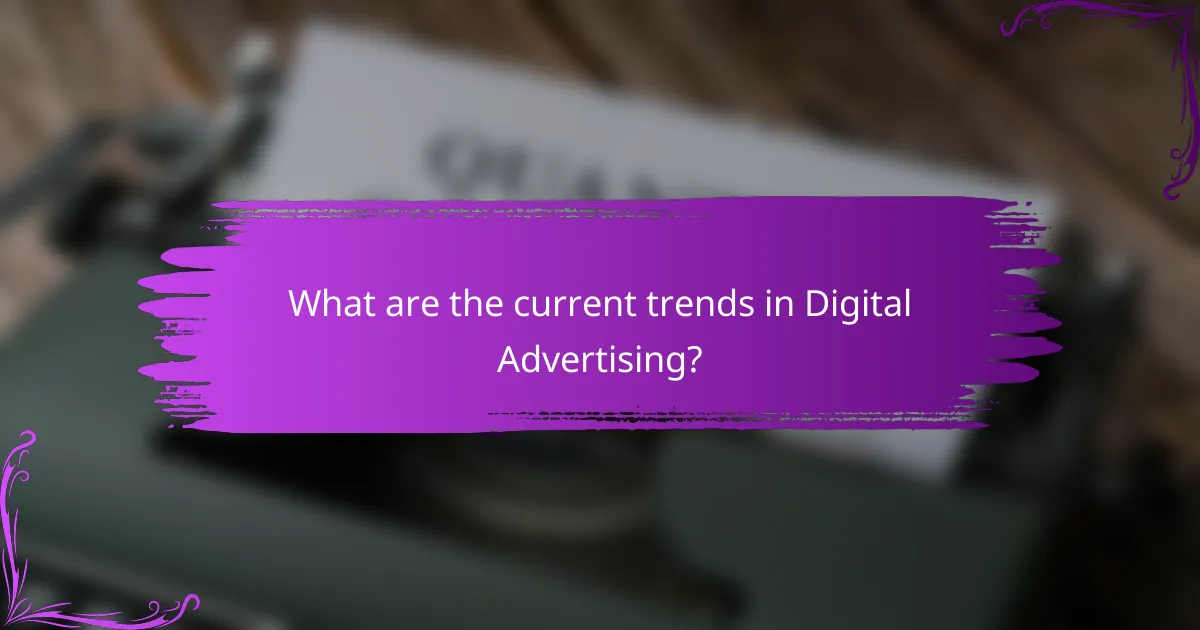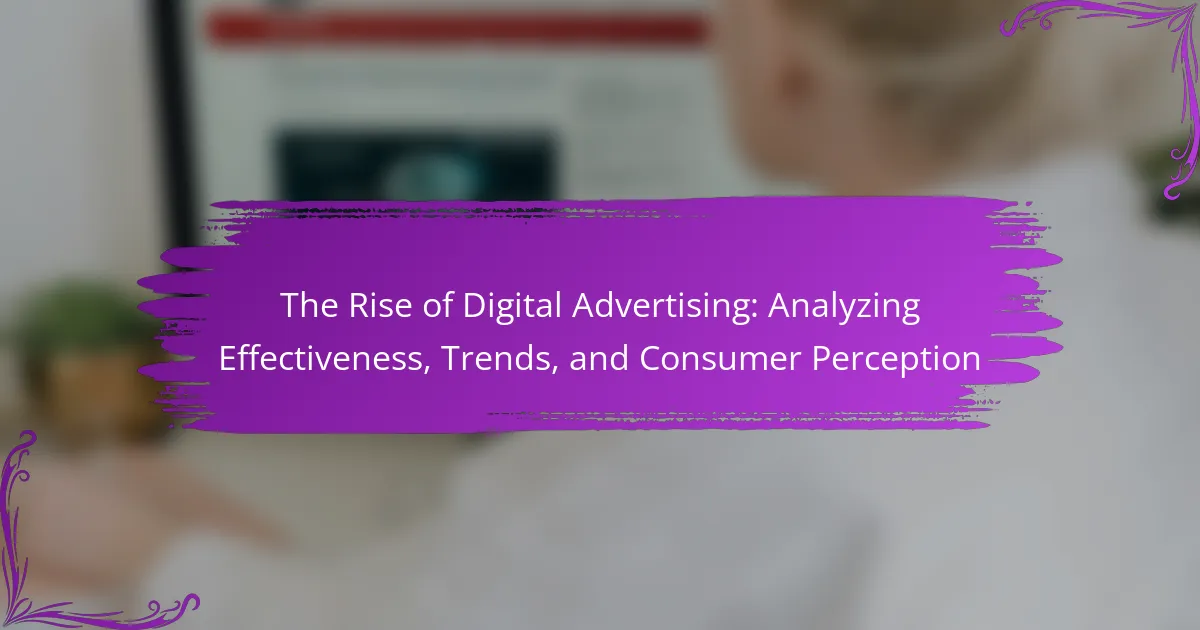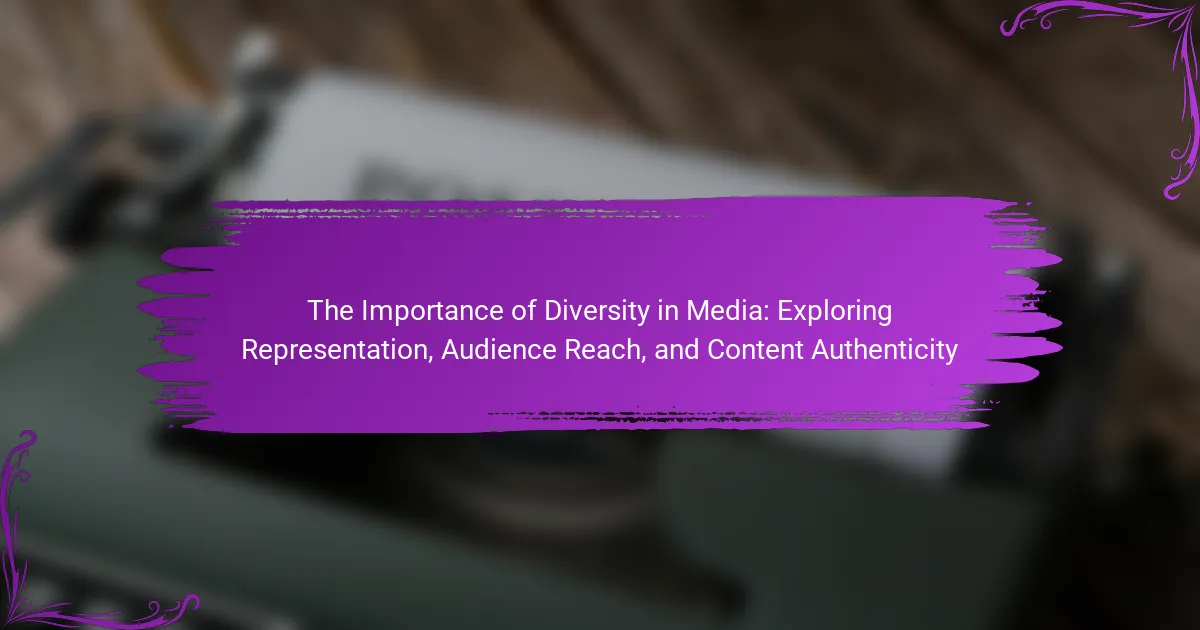
What is Digital Advertising?
Digital advertising is the promotion of products or services using digital channels. It encompasses various formats, including display ads, social media ads, and search engine marketing. Digital advertising allows for targeted messaging based on user data. This form of advertising is measurable, enabling marketers to track performance and ROI. In 2023, digital ad spending reached over $500 billion globally. This growth reflects the increasing reliance on digital platforms for consumer engagement.
How has Digital Advertising evolved over time?
Digital advertising has evolved significantly since its inception in the 1990s. Initially, it consisted of simple banner ads on websites. These early ads were often static and lacked targeting capabilities. As technology progressed, search engine marketing emerged, allowing advertisers to target users based on keywords. This shift marked a move towards more data-driven strategies.
In the 2000s, social media platforms began to rise. Advertisers leveraged these platforms for targeted advertising based on user demographics and interests. This era also saw the introduction of pay-per-click models, which further refined advertising strategies. By the 2010s, programmatic advertising became prevalent, automating the buying and selling of ad space in real time.
Today, digital advertising incorporates advanced analytics and artificial intelligence. These technologies enable hyper-targeted campaigns that can adapt in real time. According to eMarketer, digital ad spending surpassed traditional media in 2019, highlighting its dominance. The evolution of digital advertising reflects ongoing changes in technology and consumer behavior.
What technological advancements have influenced Digital Advertising?
Technological advancements that have influenced digital advertising include data analytics, artificial intelligence, and programmatic advertising. Data analytics allows advertisers to collect and analyze consumer behavior data. This leads to more targeted campaigns. Artificial intelligence enhances ad personalization and optimizes ad placements. Programmatic advertising automates the buying and selling of ad space in real-time. These technologies improve efficiency and effectiveness in reaching audiences. According to eMarketer, programmatic advertising accounted for over 80% of digital display ad spending in 2021. This reflects the significant impact of these advancements on the industry.
How do historical trends shape current Digital Advertising practices?
Historical trends significantly influence current digital advertising practices. The evolution of technology has shifted advertising from traditional media to digital platforms. For instance, the rise of the internet in the late 1990s introduced online ads. This transition allowed for targeted advertising based on user data. Social media emerged in the 2000s, further transforming how brands engage with consumers. Analytics tools now enable real-time tracking of ad performance. Historical consumer behavior trends inform current strategies, emphasizing personalization and engagement. Brands leverage insights from past campaigns to refine their messaging and reach. The growth of mobile devices has also reshaped advertising formats, prioritizing mobile-friendly content.
Why is Digital Advertising important for businesses?
Digital advertising is important for businesses because it enables targeted reach and measurable results. It allows companies to connect with specific audiences based on demographics, interests, and online behavior. This targeted approach increases the chances of conversion and engagement. According to a report by Statista, digital advertising spending worldwide is projected to reach over $500 billion by 2023. This growth indicates a shift in consumer behavior towards online platforms. Additionally, digital advertising provides real-time analytics. Businesses can track performance metrics such as click-through rates and return on investment. This data-driven insight allows for immediate adjustments to campaigns, enhancing effectiveness. Overall, digital advertising is a crucial component for modern business strategies.
What advantages does Digital Advertising offer over traditional advertising?
Digital advertising offers several advantages over traditional advertising. It provides greater targeting capabilities, allowing advertisers to reach specific demographics based on data. This precision increases the likelihood of engaging the right audience. Digital advertising is also more cost-effective. According to a study by eMarketer, digital ads can yield a higher return on investment compared to traditional media. Additionally, digital platforms enable real-time performance tracking. Advertisers can analyze metrics such as clicks and conversions immediately. This allows for quick adjustments to campaigns for better outcomes. Lastly, digital advertising supports various formats, including video, social media, and display ads, enhancing creative possibilities. These advantages position digital advertising as a more effective choice in the modern marketing landscape.
How does Digital Advertising impact brand visibility and engagement?
Digital advertising significantly enhances brand visibility and engagement. It allows brands to reach a broader audience through targeted campaigns. According to a report by Statista, global digital advertising spending reached over $500 billion in 2021. This investment translates into increased impressions and interactions with potential customers. Brands can utilize various platforms, such as social media and search engines, to engage users effectively. Data from a HubSpot study shows that 70% of consumers prefer to learn about products through content rather than traditional ads. This preference boosts engagement rates. Additionally, digital advertising provides measurable results, allowing brands to adjust strategies in real-time. Consequently, brands can optimize their visibility and engagement continuously.

What are the current trends in Digital Advertising?
Current trends in digital advertising include increased use of artificial intelligence and machine learning. Advertisers leverage AI for personalized targeting and content optimization. Video advertising continues to grow, with platforms like TikTok leading the way. Influencer marketing remains strong, as brands collaborate with social media influencers to reach niche audiences. Privacy regulations are shaping advertising strategies, pushing for transparency and user consent. Additionally, interactive content is gaining traction, enhancing user engagement. These trends reflect the evolving landscape of digital advertising, driven by technology and consumer behavior.
Which platforms are dominating the Digital Advertising landscape?
Google and Facebook dominate the digital advertising landscape. Together, they account for over 50% of global digital ad spending. Google Ads offers extensive reach through search and display networks. Facebook Ads provides targeted advertising options across its platform and Instagram. Amazon is also emerging as a key player, particularly in e-commerce advertising. TikTok has rapidly gained traction among younger audiences. These platforms leverage vast user data for effective targeting. Their dominance is supported by continuous innovation in ad formats and analytics tools.
How do social media platforms influence Digital Advertising effectiveness?
Social media platforms significantly enhance digital advertising effectiveness by enabling targeted audience engagement. These platforms collect vast amounts of user data. Advertisers utilize this data to tailor their campaigns. Targeted advertising leads to higher conversion rates. According to a study by HubSpot, personalized ads can increase click-through rates by 202%. Social media also facilitates real-time feedback from users. This feedback allows advertisers to adjust strategies quickly. Additionally, social media platforms encourage user-generated content, which boosts brand credibility. Brands that engage with users on social media see a 20-40% increase in customer loyalty.
What role does mobile advertising play in current trends?
Mobile advertising plays a crucial role in current trends by driving consumer engagement and influencing purchasing decisions. A significant portion of digital ad spending, approximately 70% in 2023, is allocated to mobile platforms. This trend is fueled by the increasing use of smartphones for online shopping and social media. Mobile ads are effective due to their ability to target specific demographics and deliver personalized content. Additionally, mobile advertising leverages location-based services to reach consumers in real-time, enhancing relevance. Studies show that mobile ads have a higher click-through rate compared to desktop ads, indicating their effectiveness. As mobile technology evolves, advertisers continue to innovate, utilizing formats like video and interactive ads to capture attention. This evolution reinforces mobile advertising’s pivotal role in shaping the digital marketing landscape.
How are consumer behaviors changing in response to Digital Advertising?
Consumer behaviors are shifting towards increased skepticism and selectivity in response to digital advertising. Many consumers now actively avoid ads through ad-blocking technologies. A survey by Statista found that 27% of internet users in the U.S. used ad blockers in 2022. Additionally, consumers prefer personalized ads that reflect their interests. This preference is supported by a study from Epsilon, indicating that 80% of consumers are more likely to engage with personalized content. Furthermore, there is a growing trend of consumers conducting research before making purchases, influenced by online reviews and social media. According to Nielsen, 92% of consumers trust recommendations from friends and family over any other form of advertising. Overall, digital advertising is prompting consumers to become more discerning and informed in their purchasing decisions.
What factors influence consumer perception of Digital Advertising?
Consumer perception of digital advertising is influenced by factors such as relevance, creativity, and trustworthiness. Relevance refers to how well the ad aligns with the consumer’s interests and needs. Ads that resonate with consumers are more likely to capture attention and foster positive perceptions. Creativity involves the originality and engagement level of the advertisement. Innovative and visually appealing ads tend to leave a lasting impression. Trustworthiness is critical; consumers prefer ads from brands that they perceive as credible and reliable. Research shows that 80% of consumers are more likely to engage with ads from trusted brands. Additionally, personal experiences with brands can significantly shape consumer perceptions. Negative experiences may lead to skepticism towards future advertisements from those brands.
How does personalization affect consumer engagement with Digital Ads?
Personalization significantly enhances consumer engagement with digital ads. Tailored content resonates more with individual preferences. This leads to increased click-through rates and improved conversion rates. Research indicates that personalized ads can lead to a 20% increase in sales. Consumers are more likely to interact with ads that reflect their interests. This engagement often translates into higher brand loyalty. A study by Epsilon found that 80% of consumers prefer personalized experiences. Thus, personalization is a key factor in effective digital advertising.

How effective is Digital Advertising?
Digital advertising is highly effective, achieving significant reach and engagement. According to a 2021 report by eMarketer, digital ad spending in the U.S. surpassed $200 billion, indicating strong investment in this medium. Research shows that digital ads can lead to a 10-20% increase in sales for brands that actively engage in online campaigns. Targeted advertising boosts conversion rates, with personalized ads resulting in a 300% higher click-through rate compared to non-targeted ads. Additionally, 54% of consumers report that they prefer online ads tailored to their interests. These statistics underscore the effectiveness of digital advertising in driving consumer behavior and brand awareness.
What metrics are used to measure Digital Advertising effectiveness?
Key metrics used to measure digital advertising effectiveness include click-through rate (CTR), conversion rate, return on ad spend (ROAS), and cost per acquisition (CPA). CTR indicates the percentage of users who click on an ad after seeing it. A higher CTR suggests effective ad engagement. Conversion rate measures the percentage of users who complete a desired action after clicking the ad. This action can be a purchase, sign-up, or download. ROAS calculates the revenue generated for every dollar spent on advertising. A higher ROAS signifies better advertising effectiveness. CPA determines the cost incurred to acquire a customer through an ad. Lower CPA indicates a more efficient advertising strategy. These metrics provide insights into the performance and impact of digital advertising campaigns.
How do conversion rates vary across different Digital Advertising channels?
Conversion rates vary significantly across different digital advertising channels. For instance, email marketing typically boasts a conversion rate of around 1-5%. In contrast, social media ads often see lower rates, averaging between 0.5-2%. Search engine marketing can achieve higher conversion rates, often ranging from 2-5%, depending on the industry. Display ads generally have the lowest conversion rates, averaging around 0.1-0.5%. These variations are influenced by factors such as audience targeting, ad quality, and the buying intent of users. A study by WordStream found that search ads tend to convert at a higher rate due to their intent-driven nature.
What is the role of A/B testing in optimizing Digital Advertising campaigns?
A/B testing plays a crucial role in optimizing digital advertising campaigns. It allows marketers to compare two versions of an ad to determine which performs better. By analyzing metrics such as click-through rates and conversion rates, marketers can make data-driven decisions. This method provides insights into consumer preferences and behaviors. A/B testing can lead to increased engagement and higher return on investment. According to a study by HubSpot, A/B testing can improve conversion rates by up to 300%. This demonstrates the effectiveness of A/B testing in refining advertising strategies.
What challenges do marketers face in Digital Advertising?
Marketers face several challenges in digital advertising. One major challenge is ad fraud, which costs businesses billions annually. According to a report by the Association of National Advertisers, ad fraud could reach $100 billion by 2023. Another challenge is the rapid evolution of technology. Marketers must constantly adapt to new platforms and tools. Additionally, data privacy regulations complicate targeting strategies. The General Data Protection Regulation (GDPR) in Europe has set strict guidelines for data usage. Marketers also struggle with audience fragmentation across multiple channels. This makes it difficult to reach a cohesive target audience. Lastly, measuring return on investment (ROI) remains a significant hurdle. Many marketers find it challenging to attribute sales directly to digital campaigns. These challenges impact the overall effectiveness of digital advertising strategies.
How do privacy regulations impact Digital Advertising strategies?
Privacy regulations significantly impact digital advertising strategies by limiting data collection and usage. These regulations, such as GDPR and CCPA, impose strict guidelines on how advertisers can gather consumer information. Advertisers must now prioritize transparency and consent in their campaigns. This shift often leads to reduced targeting precision. The effectiveness of personalized ads may decline due to restricted data access. Companies are compelled to explore alternative strategies, such as contextual advertising. This approach focuses on the content surrounding ads rather than user data. As a result, brands may invest in building first-party data relationships. Overall, privacy regulations reshape the digital advertising landscape, requiring adaptation to maintain effectiveness.
What common pitfalls should marketers avoid in Digital Advertising?
Marketers should avoid several common pitfalls in digital advertising. One major pitfall is neglecting audience targeting. Failing to define the target audience can lead to wasted ad spend. Another common mistake is not optimizing for mobile devices. Over 50% of web traffic comes from mobile users, making mobile optimization crucial. Additionally, marketers often overlook data analysis. Ignoring performance metrics can result in missed opportunities for improvement. Not having clear objectives is another frequent error. Without specific goals, measuring success becomes challenging. Lastly, marketers sometimes underestimate the importance of A/B testing. This process helps identify the most effective ad elements. Each of these pitfalls can significantly impact the effectiveness of digital advertising campaigns.
What best practices can enhance Digital Advertising effectiveness?
Utilizing data-driven strategies enhances Digital Advertising effectiveness. Implementing targeted advertising increases relevance to specific audiences. Personalization in ads boosts engagement rates significantly. A/B testing allows marketers to refine campaigns based on real-time performance. Optimizing for mobile devices caters to the growing number of mobile users. Utilizing high-quality visuals captures attention more effectively. Incorporating clear calls-to-action drives user interaction. Consistent brand messaging across platforms reinforces brand identity. These practices are supported by studies showing improved ROI and customer engagement in digital campaigns.
How can businesses create compelling ad content that resonates with consumers?
Businesses can create compelling ad content by understanding consumer needs and preferences. Conducting market research helps identify target demographics. Tailoring messages to resonate with these groups increases engagement. Utilizing storytelling techniques can make ads more relatable and memorable. High-quality visuals capture attention and enhance message retention. Incorporating social proof, like testimonials, builds trust and credibility. Data shows that personalized content leads to higher conversion rates. According to HubSpot, personalized marketing can increase engagement by up to 202%.
What strategies can improve targeting and segmentation in Digital Advertising?
Utilizing data analytics enhances targeting and segmentation in digital advertising. Data analytics allows advertisers to gather insights on consumer behavior. This includes demographic information, interests, and purchasing patterns. Machine learning algorithms can analyze vast datasets to identify trends. Segmenting audiences based on these insights leads to more personalized ads. Personalization increases engagement and conversion rates. A study by eMarketer found that targeted ads can improve ROI by up to 400%. Implementing A/B testing further refines targeting strategies. This method tests different ad variations to see which performs best. Continuous optimization based on performance data ensures effective segmentation.
The main entity of this article is digital advertising, which encompasses the promotion of products or services through various digital channels, including social media, search engines, and display ads. The article analyzes the evolution of digital advertising from its inception in the 1990s to its current state, highlighting technological advancements such as data analytics and artificial intelligence that have shaped its effectiveness. Key trends, consumer behaviors, and the impact of privacy regulations on advertising strategies are discussed, along with metrics used to measure effectiveness and best practices for optimizing campaigns. Overall, the article provides a comprehensive overview of the dynamics influencing digital advertising today.



